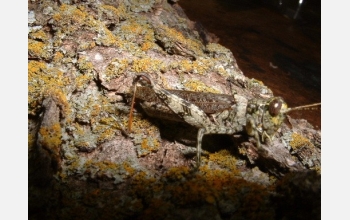News Release 05-111
Grasshopper Takes to the Trees on Prairie Research Site

The grizzly spur-throat grasshopper is nearly impossible to see against lichen-covered tree bark.
July 7, 2005
This material is available primarily for archival purposes. Telephone numbers or other contact information may be out of date; please see current contact information at media contacts.
Grass stretches as far as the eye can see across the U.S. Great Plains, and more than 100 species of grasshoppers live in the swaying fronds. But one plains-dwelling grasshopper species prefers trees to grass, as a discovery at the National Science Foundation's (NSF) Konza Prairie Long-Term Ecological Research (LTER) site shows.
A Kansas student from Fort Riley Middle School collected the first specimen while participating in Konza's LTER schoolyard project. According to Valerie Wright, Konza's education coordinator, the specimen wasn't recognized at first to be a new species to inhabit the Konza Prairie.
Konza scientist Ted Hopkins later identified the rare, tree-dwelling creature as the grizzly spur-throat grasshopper.
"LTER schoolyard projects provide wonderful opportunities for students of all ages to become involved in the excitement of science," said Henry Gholz, LTER program director at NSF. "Often, in cases such as this, students are responsible for collecting valuable field data and increasing our knowledge of the natural world."
Melanoplus punctualatus, as the grasshopper is known to scientists, was first identified in the United States in 1862. It's usually found in eastern hardwood forests and in the pine forests of the southeast. The species had been reported only twice in Kansas.
"Its discovery on Konza is a big surprise," Hopkins said.
He discovered two of the unusual grasshoppers basking in the sun on the wall of an old house located on the Konza site. Wright, who is also an entomologist, later found five more on tree trunks near the house.
The grasshopper is a large, slow-moving insect, Hopkins said, "and given its protective coloration--medium-gray speckled with dark dots, sometimes with yellowish and whitish areas--it disappears against lichen-covered tree bark."
Hopkins thinks the Konza Prairie grasshoppers are found only along wooded areas near creeks. He is continuing his research near trees where the grasshoppers have been seen, watching for tiny first-stage insects that hatch from eggs and trying to collect enough adults to determine their feeding habits.
-NSF-
Media Contacts
Cheryl L. Dybas, NSF, (703) 292-7734, email: cdybas@nsf.gov
Principal Investigators
Ted Hopkins, Konza Prairie LTER Site, (785) 537-1545, email: thopkins@ksu.edu
The U.S. National Science Foundation propels the nation forward by advancing fundamental research in all fields of science and engineering. NSF supports research and people by providing facilities, instruments and funding to support their ingenuity and sustain the U.S. as a global leader in research and innovation. With a fiscal year 2023 budget of $9.5 billion, NSF funds reach all 50 states through grants to nearly 2,000 colleges, universities and institutions. Each year, NSF receives more than 40,000 competitive proposals and makes about 11,000 new awards. Those awards include support for cooperative research with industry, Arctic and Antarctic research and operations, and U.S. participation in international scientific efforts.
Connect with us online
NSF website: nsf.gov
NSF News: nsf.gov/news
For News Media: nsf.gov/news/newsroom
Statistics: nsf.gov/statistics/
Awards database: nsf.gov/awardsearch/
Follow us on social
Twitter: twitter.com/NSF
Facebook: facebook.com/US.NSF
Instagram: instagram.com/nsfgov
